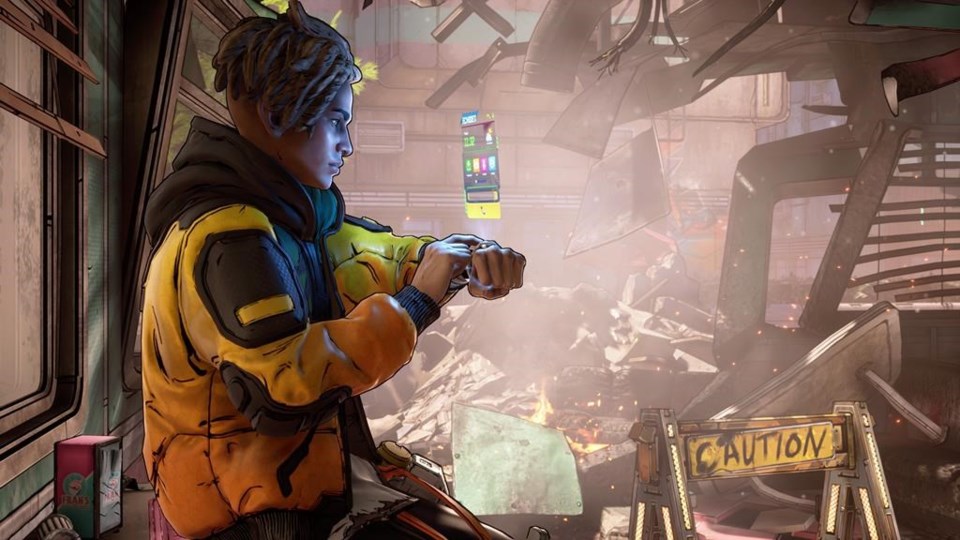Amelie Brouillette has some stories of her own about creating the "New Tales From the Borderlands" video game.
They include diving into performance capture — think upgraded motion capture — on the other side of the country during a pandemic.
"We learned a lot. There was a lot of firsts," said Brouillette, associate producer at Gearbox Studio Quebec in Quebec City.
"There was complexity involved. Not all the time but a lot. And each time it was different," she added.
Developed in collaboration with Gearbox Software in Frisco, Texas, "New Tales From the Borderlands" is the latest spinoff game from the Borderlands series that started in 2009.
The main franchise offers first-person "looter-shooter" games set in a Western/space science-fiction setting. "New Tales From the Borderlands" is a more choice-driven narrative adventure, following in the footsteps of the episodic "Tales From the Borderland" developed by Telltale Games and released in 2014.
The new title has the gamer stand up against ruthless corporate overlords in the war-torn metropolis of Promethea, controlling a trio of characters (Anu, Octavio, and Fran) "on the worst day of their lives."
After Telltale closed shop, Gearbox's Quebec City studio was tasked with overseeing the new game, which is being released Friday for Nintendo Switch, PlayStation 4 and PlayStation 5, Xbox One and Xbox Series X/S and PC.
With the choice that gamers make in "New Tales" determining what lies ahead, developers turned to performance capture to help demonstrate emotion and consequences. While motion capture essentially relies on actors to translate body movements into the game, performance capture takes it to a new level to get body, face and voice realism.
"When you have a serious moment, you want to sell that moment," said James Lopez, Gearbox Software's head of production. "Human beings are sympathetic creatures. We especially look to the eyes and the face to tell us how someone is feeling and what they're experiencing in the moment. We're not as great at reading body language, unless it's super-exaggerated … Our faces are really good at reflecting how we're feeling.
"And so we knew that we wanted to have strong storytelling in this game and we knew that storytelling is best supported with strong acting. The two combined can do a lot to help the game out."
And with a story with elements of humour, timing is all-important.
The end result is a stylized game that features striking graphic novel-type visuals.
Brouillette says some 60 actors were brought on board after an extensive process of creating storyboards and props to map out the game.
With borders closing due to the pandemic and an expected 11-month shoot, the developers opted for a studio in Canada for ease of access for Quebec studio staff like Brouillette who needed to be on hand. Beyond Capture Studio in Vancouver was chosen, mainly for availability, size and the ability to operate under strict COVID guidelines.
The studio also had experience with video games, TV shows and movies.
"Even though this is a video game it's much more cinematically driven," explained Lopez. "There's a lot of close-ups of faces, there's big acting going on. They were already more familiar with that type of complexity than some of the other stages we looked at. So it was a pretty good arrangement."
While Gearbox has used motion capture before, this game took it up a notch — with a major perk of performance capture being that the right take can be put into the game almost immediately.
"It's a considerable upfront investment time-wise, because there's so much more planning … We were looking anywhere from two to three months prep time before we could do a performance capture shoot," said Lopez. "So it's a lot more upfront investment but once it's done, you're basically good to go, with some caveats in there."
Brouillette noted one fight scene that lasts two to five minutes in the game took eight hours to shoot.
Brouillette lived in Vancouver for two months during the shoot. Those back in Quebec City watched what was going on via Zoom.
There were also the challenge of COVID, with social distancing and regular testing, as well as working with different time zones. If someone got sick, shooting was closed down for 10 days to avoid further contamination. And Brouillette had body-doubles in reserve, just in case.
"We were lucky we didn't have to call them but this is the kind of strategy that we had to adapt to be able to face everything that could happen," said Brouillette.
Still there were stoppages. Fortunately more than half of the game was shot before anyone got sick.
The Quebec City studio also helped with "Borderlands 3" and "Tiny Tina's Wonderlands" as well as downloadable content for "Borderlands 2."
Gearbox also has an office in Montreal, with some 300 employees split between the two Quebec studios.
---
Follow @NeilMDavidson on Twitter
This report by The Canadian Press was first published Oct. 20, 2022
Neil Davidson, The Canadian Press


